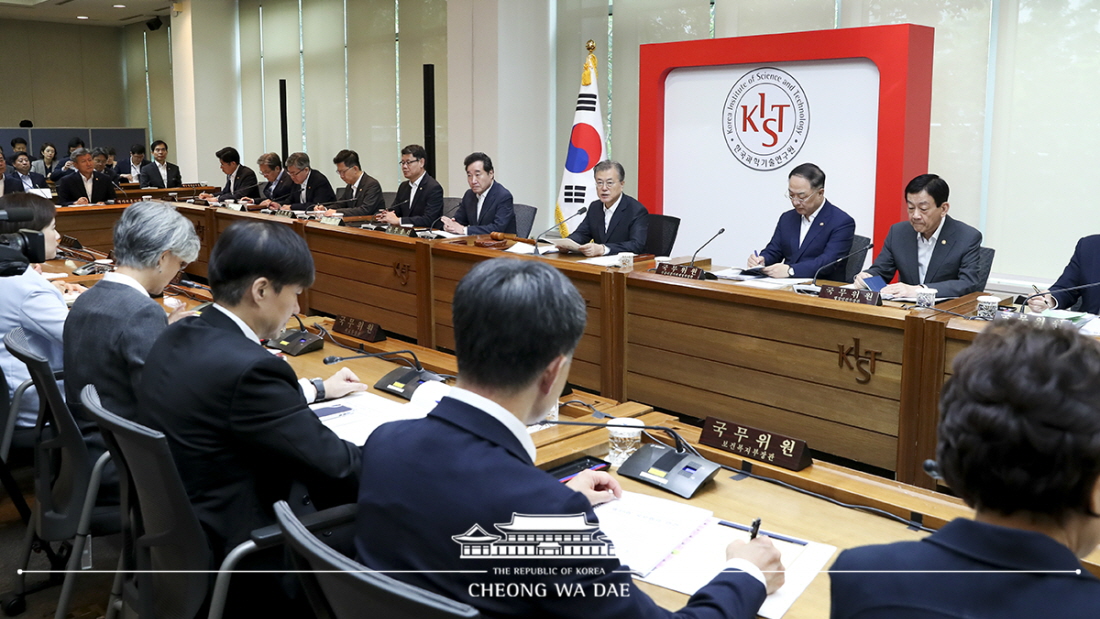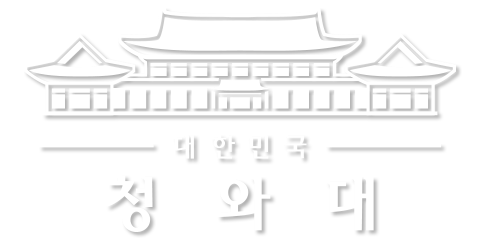이 웹사이트는 제19대 대통령 임기 종료에 따라 대통령기록관이 「대통령기록물 관리에 관한 법률」에 의해 이관받아 서비스하는 대통령기록물입니다. 자료의 열람만 가능하며 수정 · 추가 · 삭제는 불가능합니다.
다만, 「개인정보보호법」에 의하여 개인의 정보를 보호받기 원하시는 분은 관련 내용(요청자, 요청내용, 연락처, 글위치)을 대통령 웹기록물 담당자(044-211-2253)에게 요청해 주시면 신속히 검토하여 조치해 드리겠습니다. 감사합니다.
SPEECHES & REMARKS
BRIEFINGS
Opening Remarks by President Moon Jae-in at Cabinet Meeting on Competitiveness of Materials, Parts and Equipment Industries

Let me begin the 39th Cabinet Meeting.
Today’s Cabinet Meeting is being held at the Korea Institute of Science and Technology to reflect our extraordinary determination and resolve to create a strong economy that cannot be shaken. It is the second Cabinet Meeting held outside of a government building following the one in February held at the Kim Koo Museum to renew the commitment to our future over the next 100 years.
KIST is the cradle of science and technology for the Republic of Korea. When Korea was nothing short of barren in the fields of science and technology, KIST was established under a banner proclaiming science and technology-based nation building and technological independence. Since then, the Institute has made all-out efforts for the self-reliant development of technology and localization. The blue prints for our core industries that spearheaded the Miracle on the Hangang River – steelmaking, shipbuilding, semiconductors and automobiles – were laid out here.
The Institute has now become a pacesetter in developing original technology to lead the world, having evolved from a follower catching up with advanced countries’ technology. The Robotics and Media Institute that works on futuristic robots and the Post-silicon Semiconductor Institute that I just visited a short while ago exemplify these endeavors. I urge you all to take to heart the meaning of holding this Cabinet Meeting here at this center for science and technology that is fueling construction of an economic powerhouse.
Enhancing the competitiveness of the materials, parts and equipment industries is the nation’s strategic mission in order to become an economic powerhouse. It is the work of forging the framework for the Korean economy’s next 100 years, taking it beyond the influence of Korea-Japan relations. Strengthening the competitiveness of the materials, parts and equipment industries is the path toward innovation in manufacturing and our resurgence as a manufacturing powerhouse. It is the essential element of competitiveness in manufacturing.
Improving the fundamental competitiveness of the materials, parts and equipment industries, in particular, requires the speedy self-reliant development of core technology. Manufacturers in these industries account for half of all of our production and employment in manufacturing. They are mostly SMEs and mid-market companies. Fostering the materials, parts and equipment industries is the same as fostering SMEs and mid-market businesses and creating an industrial ecosystem where SMEs and large companies can work together. It is the way to lay the foundation for sustainable growth by addressing our economy’s long-accumulated structural problems.
Bolstering the competitiveness of our materials, parts and equipment industries also constitutes a strategy to proactively respond to changes in the global economy and trade environment. It must be pursued to prepare for the growing protectionism, spreading uncertainty and even changing structure of the international division of labor.
Over the past two months, strengthening the competitiveness of our materials, parts and equipment industries, as a national strategic mission both in name and substance, has gained momentum for implementation. A consensus has been formed at the national level upon an outpouring of encouragement and support from citizens to large businesses and SMEs as well as universities and research institutions. This unprecedented phenomenon has become a great boost.
Building upon this, the Government is pushing ahead with localizing technology, securing stable supplies and strengthening industrial competitiveness at the same time by mobilizing all resources available.
Concrete changes have already started. We have embarked on technological development for 25 key items for which Korea is highly reliant on a specific country in a bid to replace them with local products. The localization of materials used in semiconductor production is about to be realized. Those large companies and SMEs that succeeded in locally manufacturing parts pooled their strengths to establish mutually beneficial smart factories. We can look upon this as the start of a virtuous cycle of public understanding, government policies and changes in industrial fields.
The Government intends to accelerate positive changes through special countermeasures and approaches that differ from those of the past.
First, as we have stressed many times, government investment will be boldly increased. Technological competitiveness in materials, parts and equipment must be accompanied by long-term investment and R&D. In next year’s budget, the funds to increase self-reliance in materials, parts and equipment will more than double compared to that of this year, and 5 trillion won will be intensively invested in that regard over the next three years.
That amount nearly equals the 5.4 trillion won injected over the past 19 years since passage of the Act on Special Measures for the Promotion of Specialized Enterprises, etc., for Materials and Components. To speed up technological development for core items, preliminary feasibility study exemptions for R&D projects worth 2 trillion won have been confirmed.
Second, a special focus will be placed on establishing cooperative relations among businesses and linking R&D and production. Due to the materials, parts and equipment industries’ characteristics, close collaboration between buyers and suppliers in the entire process from product planning and development to stable sales is important.
To promote cooperation among businesses, the Government will provide a package of tax, financing, location assistance and special exemptions from regulations. Demonstration and mass production test beds that pair supplier’s technological developments with buyer’s applications will be expanded. Startups and hidden champions that have high growth potentials will be assisted so that they can be nurtured as global enterprises specialized in materials, parts and equipment.
Third, we will facilitate and support changes in industrial fields through strong implementation systems. The materials, parts and equipment competitiveness committee that we’re going to approve at the Cabinet Meeting today will become a control tower and focus on promoting the establishment of cooperative models among businesses and improving related laws. The existing sunset law that covers materials and parts only will be expanded to cover equipment, and it will be completely overhauled into a permanent law in order to strengthen the legal foundation further.
I returned from a tour to Thailand, Myanmar and Laos last week. With this, I’ve wrapped up my plan to visit all 10 ASEAN member states earlier than expected. Korea and Thailand agreed to step up cooperation in national defense and the defense industry on the basis of the friendship between our two countries, which fought together in the Korean War. In addition, it was agreed that bilateral cooperation will be further expanded into cutting-edge industries by linking Korea’s innovative growth strategy and Thailand’s strategy for industrial sophistication.
Korea and Myanmar, with its high growth potential, laid a foundation for sustainable and stable economic cooperation. The Korea-Myanmar Industrial Complex will be the starting point to that end.
I made a state visit to Laos, the first by a Korean president. There, it was agreed that our two countries will increase cooperation on water resources and promote collaboration in the fields of agriculture and public health. The Republic of Korea-Mekong Vision unveiled in Laos will serve as a milestone in taking ties with the Mekong nations to a new level.
Completing the plan to visit all 10 ASEAN nations is all the more meaningful as this year marks the 30th anniversary of the establishment of Korea-ASEAN relations. Enhanced cooperation with ASEAN member states is a must – not an option – to bring peace to the Korean Peninsula and achieve sustainable prosperity. Now ASEAN and Korea have become inseparable friends that share each other’s experiences and possibilities for the sake of a shared future.
Cooperation with ASEAN will revitalize the Republic of Korea’s economy. We will also upgrade collaboration in all areas, including foreign affairs and national security.
With the completion of the tour to all 10 ASEAN member states, the hope for a future where Korea and ASEAN prosper together has grown further. I have witnessed ASEAN’s dynamism and growth potential and reaffirmed its active support for our New Southern Policy. Together, we envisioned the future of Korea and ASEAN: a people-centered community of peace and prosperity.
The ASEAN-Republic of Korea Commemorative Summit and the inaugural Mekong-Korea Summit to be held in Busan in November will serve as important opportunities to add substance to our determination to cooperate and usher in a future of mutual prosperity. There’s not much time left. These will be the biggest multilateral summits to be held in Korea since my Administration was launched. I ask the host city of Busan and all the ministries and agencies to work together to their utmost so that the events can be held successfully amid public interest and support.



